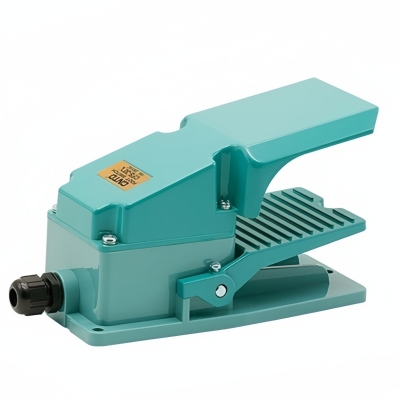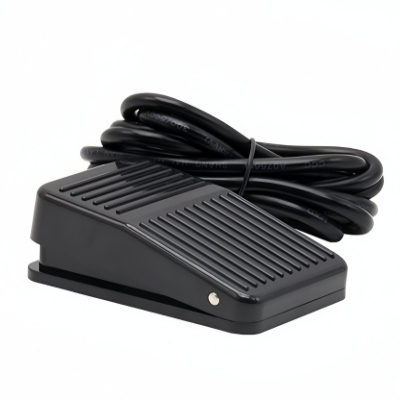Momentary Foot Pedal Switch vs. Electric Foot Switch
A foot switch is a way to control the on and off of a circuit by stepping on it, thereby realizing the start, stop, reversal or other control functions of mechanical equipment or production processes. The main function is to replace the operation of both hands, especially when the hands are inconvenient or cannot reach the control circuit, and the start, stop or other operations of the equipment are controlled through foot pressure. In addition, the foot switch can also be used to control the output current.
The structure of the foot switch mainly includes a pedal, a base, a micro switch, and other parts. The pedal is responsible for receiving foot pressure. A micro switch is installed on the base. When the pedal is under pressure, the action of the micro switch controls the on and off of the circuit. They can be roughly divided into electric foot switches and momentary foot switches. ATO Industrial Automation will briefly introduce the differences between these types of foot switches.
Momentary Foot Switch
A momentary foot switch is a foot switch that instantly turns on the power when stepped on and automatically turns off when released. This type of switch is usually used in situations where short-term power operation is required.

The working principle of a momentary foot switch is usually based on a combination of mechanical and electrical. When the user presses the switch, the force of the foot causes the mechanical component to move, triggering an internal mechanical switch such as a spring contact or roller switch. Movement of the mechanical switch causes the two contact points to rapidly close (for a normally closed switch) or open (for a normally open switch). This action is instantaneous, hence the name "instantaneous." Closing or opening a contact momentarily connects or disconnects the circuit, thereby providing an electrical signal to the connected device or control system. Once the pedal force disappears, the mechanical component returns to its original position due to spring force or another recovery mechanism, causing the contact point to open (for a normally closed switch) or close (for a normally open switch) again. Due to the instantaneous action of the switch, the connected device or control system will perform corresponding operations according to the change of status of the switch. Key features of the momentary foot switch include:
Quick Response
The switch can respond quickly to foot movements, turning on the power immediately when you step on it, and turning off the power immediately when you release it.
Safety Design
Instantaneous switches can reduce safety hazards caused by long-term power on and avoid unnecessary electrical accidents.
Convenient Operation
The equipment can be controlled through foot operation, freeing up both hands and improving the convenience and efficiency of operation.
Different Types
According to different application requirements, there are many types of instantaneous foot switches, such as push type, floating type, locking type, etc.
Electrical Characteristics
This type of switch usually has certain current and voltage specifications to adapt to different electrical equipment needs.
Environmental Adaptability
The instantaneous foot switch may need to have a certain level of protection, such as dustproof, waterproof, etc., to adapt to different usage environments.
Electric Foot Switch

Electric foot switches are designed with ergonomics and ease of operation in mind, allowing users to control the device hands-free. The sensor is a key part of the electric foot switch, which can detect changes in the pressure of the foot or the movement of the foot approaching. When the user steps on or approaches the sensor area of the electric foot switch, the sensor detects the foot movement and sends an electrical signal to the control unit to analyze the signal and trigger the actuator, which performs corresponding actions according to the instructions of the control unit. The action of the actuator is instantaneous. Once completed, the electric foot switch will return to its initial state and wait for the detection of the next foot action.
Momentary Foot Pedal Switch vs Electric Foot Switch
Momentary foot switch and electric foot switch are two types of control switches widely used in different application scenarios. They differ in terms of working principles, structural design, usage environment, and functional characteristics. This article will conduct a detailed comparative analysis of these types of foot switches.
Working Principle
A momentary foot switch usually refers to a switch that can instantly turn on or off a circuit through a brief foot pressure. Its characteristic is that it produces action when the foot pedal is depressed and quickly returns to its original state after being released. In contrast, an electric foot switch usually refers to a foot switch that contains an electric mechanism, which can control the action of certain equipment through electricity, such as the opening and closing of an electric door. Electric foot switches may have a locking feature that holds the foot pedal in place after the pedal is depressed until the pedal is depressed or released again.
Structural Design
The structural design of the momentary foot switch is usually relatively simple, mainly consisting of a pedal, a base, and an internal micro switch. The structure of the electric foot switch is more complex and may include motors, reducers, sensors, and other components to achieve more complex control logic.
Usage Environment
Momentary foot switches are usually used in an emergency stop, safety switch control, and other situations due to their simple operating characteristics and quick response characteristics. Electric foot switches are more suitable for applications that require long-term control, such as the opening and closing control of electric doors, because of their ability to maintain status.
Features
The functional characteristic of the momentary foot switch is mainly to provide a fast on-off control, which is suitable for scenarios that require quick response. Electric foot switches can provide a variety of control modes according to specific designs, such as speed control, direction control, etc., and are suitable for equipment that requires multi-level control or continuous operation.
Comprehensive Comparison
| characteristic | Momentary foot switch | Electric foot switch |
| working principle | cruise | Electric control, including the control function |
| Structural design | Brief | quite complicated |
| Usage Environment | Emergency stop, quick response | Long-term control, multi-level operation |
| Features | On/off control | Speed, direction, state control, etc. |

